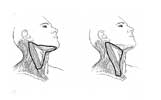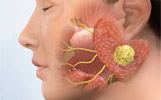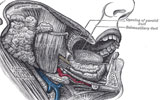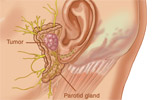Information about head and neck surgery
Laser microsurgery is a common procedure used to remove irregularities in the larynx (voice box) that can affect voice production. This page contains information on when laryngeal microsurgery is required, how the procedure is performed as well as the risks and recovery processes involved.
Recovery after neck surgery
 After neck surgery you may develop neck soreness and stiffness. Once the initial discomfort and pain after neck surgery passes you should increase and / or maintain your neck and shoulder motion and strength through an exercise program. Find out more about ways to help you recover after neck surgery.
After neck surgery you may develop neck soreness and stiffness. Once the initial discomfort and pain after neck surgery passes you should increase and / or maintain your neck and shoulder motion and strength through an exercise program. Find out more about ways to help you recover after neck surgery.
Parathyroid
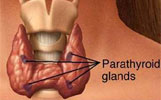 The parathyroid glands are four pea-sized glands located on the thyroid gland in the neck – though their names are similar, the thyroid and parathyroid glands are entirely different glands, each producing distinct hormones with specific functions.
The parathyroid glands are four pea-sized glands located on the thyroid gland in the neck – though their names are similar, the thyroid and parathyroid glands are entirely different glands, each producing distinct hormones with specific functions.
Zenkers diverticulum
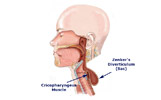 Zenkers diverticulum is more common in men than women and is more commonly seen in peoply over 60 years of age. Affected people may suffer from long-standing difficulty with eating and drinking (dysphagia), regurgitation, bad breath, weight loss, and even aspiration (the passage of food or other hazardous material into the lungs).
Zenkers diverticulum is more common in men than women and is more commonly seen in peoply over 60 years of age. Affected people may suffer from long-standing difficulty with eating and drinking (dysphagia), regurgitation, bad breath, weight loss, and even aspiration (the passage of food or other hazardous material into the lungs).
Recognising symptoms for early detection of cancer
Early detection of head and neck cancer
- Tobacco use is the most preventable cause of death from head and neck cancer
- While lung cancer cases are decreasing, cancers in the head and neck appear to be increasing, but they are curable if caught early
- Fortunately, most head and neck cancers produce early symptoms
- You should know the potential warning signs so you can alert your doctor as soon as possible
- Remember—successful treatment of head and neck cancer depends on early detection – knowing and recognising its signs can save your life
Symptoms of head and neck cancer
A lump in the neck
- Cancers that begin in the head or neck usually spread to lymph nodes in the neck before they spread elsewhere
- A lump in the neck that lasts more than two weeks should be seen by a doctor as soon as possible
- Of course, not all lumps are cancer – but a lump (or lumps) in the neck can be the first sign of cancer of the mouth, throat, voice box (larynx), thyroid gland, or of certain lymphomas and blood cancers
- Such lumps are generally painless and continue to enlarge steadily
Change in the voice
- Most cancers in the larynx cause some changes in voice
- An ENT – head and neck specialist can examine your vocal cords easily and painlessly
- While most voice changes are not caused by cancer, you shouldn’t take chances
- If you are hoarse or notice voice changes for more than two weeks, see your doctor who will arrange for you to see an ENT specialist as needed
A growth in the mouth
- Most cancers of the mouth or tongue cause a sore or swelling that doesn’t go away
- These may be painless, which can be misleading
- Bleeding may occur, but often not until late in the disease
- If an ulcer or swelling is accompanied by lumps in the neck, you should be concerned
- In addition, any sore or swelling in the mouth that does not go away after a week should be evaluated by a doctor
- Your dentist or doctor can determine if a biopsy (tissue sample test) is needed and can refer you to a head and neck surgeon who can perform this procedure
Bringing up blood
- This is often caused by something other than cancer
- However, tumors in the nose, mouth, throat, or lungs can cause bleeding
- If blood appears in your saliva or phlegm for more than a few days, you should see your doctor
Problems with eating and drinking
- Cancer of the throat or oesophagus (gullet or swallowing tube) may make swallowing solid foods—and sometimes liquids—difficult
- The food may “stick” at a certain point and then either go through to the stomach or come back up
- If you have trouble almost every time you try to swallow something, you should be examined by a physician
- Usually a barium swallow x-ray or an oesophagoscopy (direct examination with a scope) will be performed to find the cause
Changes in the skin – skin cancer
-
BCC
- The most common head and neck cancer is basal cell cancer (BCC) of the skin
- Fortunately, this is rarely serious if treated early
- Basal cell cancers appear most often on sun-exposed areas like the forehead, face, and ears, but can occur almost anywhere on the skin
- BCC often begins as a small, pale patch that enlarges slowly, producing a central “dimple” and eventually an ulcer
- Parts of the ulcer may heal, but the major portion remains ulcerated
- Some basal cell cancers show colour changes
SCC and melanoma
- Other kinds of cancer, including squamous cell cancer (SCC) and malignant melanoma, also occur on the head and neck
- Most squamous cell cancers occur on the lower lip and ear
- They may look like basal cell cancers, and if caught early and properly treated, usually are not dangerous
- If there is a sore on the lip, lower face, or ear that does not heal, consult a doctor
- Malignant melanoma typically produces a blue-black or black discolouration of the skin
- However, any mole that changes size, colour, or begins to bleed may mean trouble
- A black or blue-black spot on the face or neck, particularly if it changes size or shape, should be seen as soon as possible by a dermatologist or ENT specialist
Persistent earache – head pain – neck pain
- Constant pain in or around the ear when you swallow can be a sign of infection or tumor growth in the throat
- This is particularly serious if it is associated with difficulty in swallowing, hoarseness, or a lump in the neck
- These symptoms should be evaluated by an ENT specialist
Identifying high risk of head and neck cancer
- As many as 90 percent of head and neck cancers arise after prolonged exposure to specific risk factors
- Use of tobacco (cigarettes, cigars, chewing tobacco, or snuff) and alcoholic beverages are the most common cause of cancers of the mouth, throat, voice box, and tongue
- In adults who do not smoke or drink, cancer of the throat can occur as a result of infection with the human papilloma virus (HPV)
- Prolonged exposure to sunlight is linked with cancer of the lip and is also established as a major cause of skin cancer
What you should do
- All of the symptoms and signs described here can occur with no cancer present
- In fact, many times complaints of this type are due to some other condition – but you can’t tell without an examination – so if they do occur, see your doctor to be sure who will arrange for you to see an ENT specialist
- Remember—when found early, most cancers in the head and neck can be cured
- Cure rates for these cancers could be greatly improved if people would seek medical advice as soon as possible
- Play it safe – if you detect warning signs of head and neck cancer, see your doctor immediately – and practice health habits which help prevent these diseases


